Prototype truck trailers could help pull their own loads
Startup says its electric-powered trailers would reduce truck emissions.

The principle of moving freight with a tractor-trailer rig has always been pretty simple: The tractor pulls the trailer. That basic idea is baked into logistics terminology like “hauling freight” or calling the tractor a “power unit.”
But what if the trailer could also help to move the load? That’s the idea behind Range Energy, a Mountain View, California-based startup that says it is bringing electric-powered trailers to the commercial trucking market. Backed by $8 million in seed capital, the company is now testing prototype powered trailers and will then test its design alongside commercial partners.
The company says its powered trailers are compatible with today’s diesel-powered tractors as well as tomorrow’s all-electric versions. And if it succeeds in achieving mass market adoption before electric semi-trucks are deployed at scale, the firm posits, it could help reduce the operational disruptions of a changeover from diesel to battery.
In the meantime, Range Energy claims its trailers could reduce tractor-trailers’ greenhouse gas emissions by 40% while reducing fuel costs. “Our powered trailers seamlessly meet fleet owners’ short- and long-term decarbonization goals by easing the transition to electrification while simultaneously mitigating the risks of economic penalties associated with emerging mandates,” CEO and founder Ali Javidan, a former Tesla executive, said in a press release.Related Articles
Copyright ©2024. All Rights ReservedDesign, CMS, Hosting & Web Development :: ePublishing